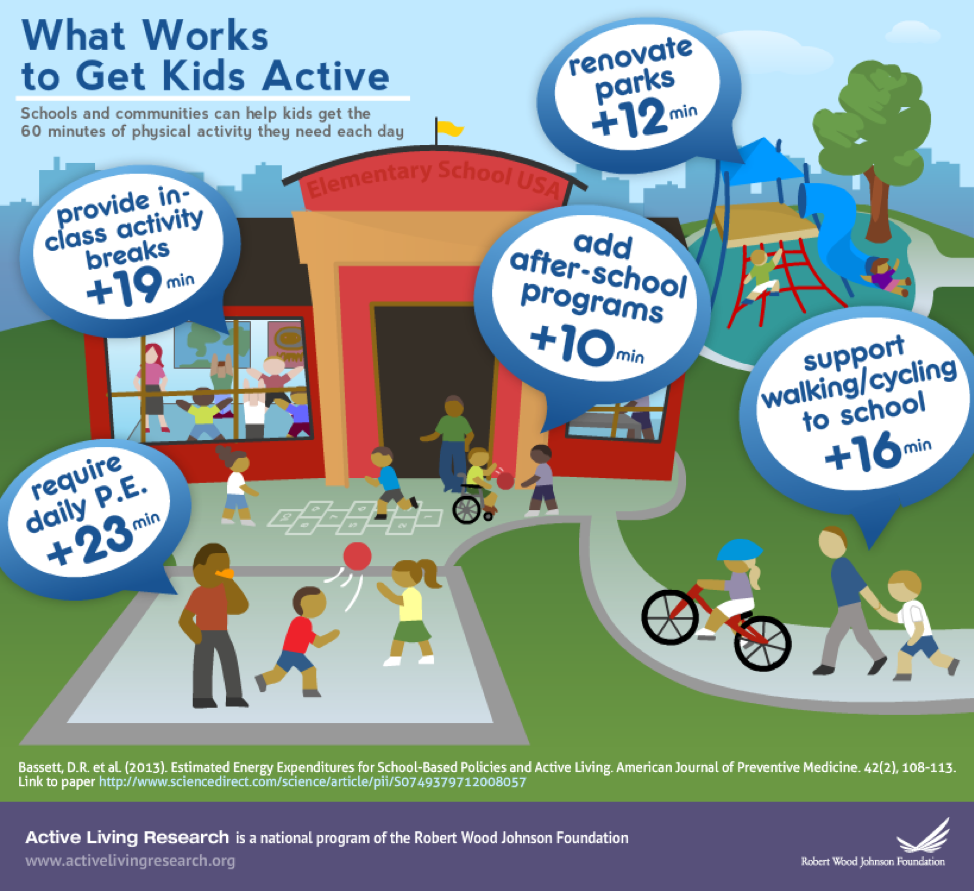It is recommended that school-aged children and adolescents participate in at least 60 minutes of moderate-to-vigorous physical activity. For instance, at the intensity of a brisk walk or more. In order to achieve health-benefits, they should do this each day.
The Challenge
Schools have been tasked with contributing at least 30 minutes of that recommendation throughout the school day (Institute of Medicine [IOM], 2013). While that seems like an achievable task, research tells us that students spend a significant amount of time at school participating in sedentary behaviors (i.e., sitting) and often do not meet those recommendations. Physical activity during the school day such as classroom movement integration, recess, etc. has been suggested as a way to get students closer to the 60-minute bench mark. In fact, incorporating movement into the classroom can contribute up to 19 minutes of moderate-to-vigorous physical activity for students per day.
Students Want to Move!
Teachers have reported a lack of time during the day to integrate physical activity into their classrooms. They have many responsibilities when it comes to academic requirements that they often do not feel like they have the time to “add” something else – in this case physical activity. However, there are many physical and mental health benefits associated with physical activity (IOM, 2013), and students have reported wanting to move more throughout the school day.
Classroom Activity Increases Productivity
What if I said you might actually save time by incorporating short bouts of physical activity throughout the day? Research has shown that students who participate in only 10-minutes of physical activity have improved on-task behavior (Howie, Beets, & Pate, 2014). In addition, math performance increased after classroom-based physical activity. As a result, physical activity during the day can have positive impacts on overall student cognition.
So, when should you incorporate movement in your classroom? Given what we know about how exercise stimulates the brain, you might consider incorporating movement. As a result, this would break up extended sedentary times during the day. Especially, on days that students do not have physical education class, and before important tests or academic tasks.
When to Incorporate Classroom Activities?
There are many benefits incorporating physical activity into class can produce. Therefore, you might now be asking yourself, “How can I find the time to incorporate more movement into my classroom?” Consider this list of tips and tricks to maximize time in your classroom:
Before Classroom Physical Activity
- Have students clear the floor of clothes, bags, etc.
- Prompt students on safety (i.e., watch out for desks and others, stay in control, etc.)
- Establish start and stop signals
- Provide clear instructions so students know when and how to move
During Classroom Physical Activity
- Remind students of safety
- Incorporate movement with academic content
- Participate with your students – they see you as a role model
- Incorporate physical activity lessons/breaks that require little to no equipment
- Use your established start and stop signals consistently
After Classroom Physical Activity
- Establish a calm-down routine (i.e., stand behind your desk and take three deep breaths before sitting back down)
- Remind students to quickly and quietly move back to their work stations
- If you used any equipment, have students help collect it and put it away
References
Basset, D.R. et al. (2013). Estimated Energy Expenditures for School-Based Policies and Active Living. American Journal of Preventive Medicine, 44(2), 108-113.
Centers for Disease Control and Prevention (2013). Comprehensive School Physical Activity Programs: A Guide for Schools. Atlanta, GA: U.S. Department of Health and Human Services.
Centers for Disease Control and Prevention (2010). The association between school based physical activity, including physical education, and academic performance. Atlanta, GA: U.S. Department of Health and Human Services.
Donnelly, J.E., & Lambourne, K. (2011). Classroom-based physical activity, cognition, and academic achievement. Preventive Medicine, 52, S36-S42.
Hillman, C.H., Pontifex, M.B., Raine, L.B., Castelli, D.M., Hall, E.E., & Kramer, A.F. (2009). The effect of acute treadmill walking on cognitive control and academic achievement in preadolescent children. Neuroscience, 159(3), 1044-1054.
Howie, E.K., Schatz, J., & Pate, R.R. (2015). Acute Effects of Classroom Exercise Breaks on Executive Function and Math Performance: A Dose-Response Study. Research Quarterly for Exercise and Sport, 86(3), 217-224.
References (cont.)
Howie, E. K., Beets, M. W., & Pate, R. R. (2014). Acute classroom exercise breaks improve on-task behavior in 4th and 5th grade students: A dose–response. Mental Health and Physical Activity, 7(2), 65-71.
McMullen, J.M., MacPhail, A., & Dillon, M. (2018). “I want to do it all day!”—Students’ experiences of classroom movement integration. International Journal of Educational Research, doi.org/10.1016/j.ijer.2018.11.014.
Michael, R.D., Webster, C.A., Egan, C.A., Nilges, L., Brian, A., Johnson, R. & Carson, R.L. (2019). Facilitators and Barriers to Movement Integration in Elementary Classrooms: A Systematic Review, Research Quarterly for Exercise and Sport, DOI: 10.1080/02701367.2019.1571675
Nettlefold, L., McKay, H.A., Warburton, D.E., McGuire, K.A., Bredin, S.S., & Naylor, P.J. (2011). The challenge of low physical activity during the school day: At recess, lunch and in physical education. British Journal of Sports Medicine, 45(10), 813–819.
US Department of Health and Human Services (2018). Physical Activity Guidelines for Americans, 2nd edition. Washington, DC: US Department of Health and Human Services.

Dr. McMullen is an Associate Professor of Physical Education and Physical Activity Leadership. Her research focuses on whole-of-school physical activity promotion and she is particularly interested in teacher and student voice when it comes to promoting physical activity in schools. Her personal interests include being active, spending time with family and friends, and traveling to all corners of the world.






Leave A Comment